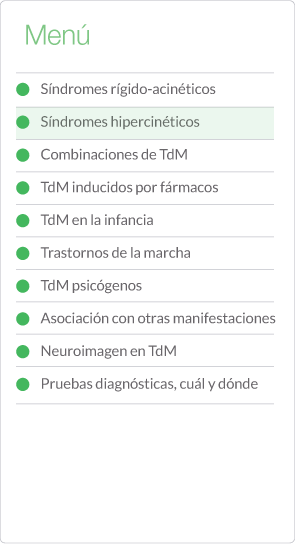Bibliografía
- Caviness JN, Brown P. Myoclonus: current concepts and recent advances. Lancet Neurology 2004;3:598-607.
- Gordon MF. Toxin and drug-induced myoclonus. Adv Neurol 2002;89:49-76.
- Klawans HL, Carvey PM, Tanner CM, Goetz CG. Drug-induced myoclonus. In: Fahn S, Marsden CD, Van Woert MH, eds. Myoclonus. New York: Raven Press; 1986:251-64.
- Lang AE. Miscellaneous drug-induced movement disorders. In: Lang AE, Weiner WJ, eds. Drug-induced movement disorders. New York: Futura Publishing; 1992: 339-81.
- Marsden CD, Hallet M, Fahn S. The nosology and pathophysiology of myoclonus. In Marsden CD, Fahn S, editors. Movement Disorders. London: Butterworhs;1982.p.196-248.
- Sethi KD, Morgan JC. Drugs induced movement disorders. In Jankovik J, Tolosa E editors. Parkinson´s Disease and Movement Disorders. Phyladelphia Lippincott Williams & Wilkins. 2007:394-408.
- Zimprich A, Grabowski M, Asmus F, et al. Mutations in the gene encoding epsilon-sarcoglycan cause myoclonus-dystonia syndrome. Nat Genet 2001;29:66-69.
- van der Salm SM, Koelman JH, Henneke S, van Rootselaar AF, Tijssen MA. Axial jerks: a clinical spectrum ranging from propriospinal to psychogenic myoclonus. J Neurol 2010;257: 1349–55
- Glass GA, Ahlskog JE, Matsumoto JY. Orthostatic myoclonus: a contributor to gait decline in selected elderly. Neurology 2007;68: 1826–30.
- Venot M,Weiss N, Espinoza S, Imbert A, Tadie JM, Fagon JY, et al. Improvement of early diagnosed post-anoxic myoclonus with levetiracetam. Intensive Care Med. 2010
- Hu S-C, Frucht SJ, Shibasaki H. Myoclonus. Therapeutics of Parkinson´s Disease and other Movement Disorders. In Hallet M,Poewe W eds. John Willey & sons LTD UK 2008:363-370.

